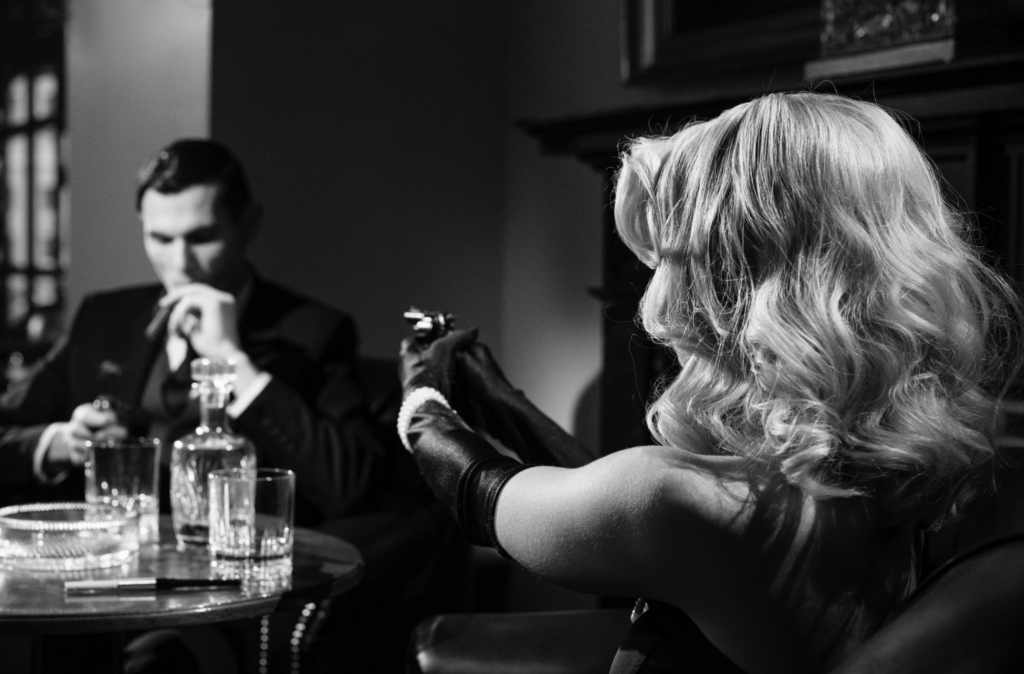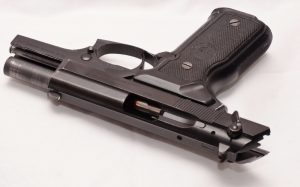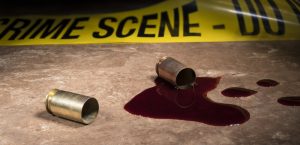

Silencers. Yes, today our visiting expert, Piper Bayard from the writing duo Bayard & Holmes is here to do some myth-busting. The movie industry seems to believe one can use a silencer on everything.
***Yet another peeve for many who are even remotely knowledgable about the gun world and how things actually work.
I get that fiction is supposed to be over the top, especially with spies and thrillers. It doesn’t matter that most spies actually do boring office work and are usually as ‘sexy’ as our 6th grade librarian. Hollywood doesn’t care that most intelligence operatives and assassins are more likely to drive a Mazda than a Maserati.
In reality, drawing a lot of attention and being SUPER memorable is a BAD thing.
This said, we don’t care when it comes to fantasy. Spies and assassins are sexy in fiction. And it is TOTALLY possible to hold onto a bullet train traveling at up to 200 miles an hour….in fiction.
So how can we keep our fiction imaginative, over-the-top and sexy AND gain at least a modicum of respect from those who are savvy about this topic? *drum roll* Well this THURSDAY y’all can take my class The Edge: How to Write Mystery, Suspense & Thriller (sigh up HERE). This is a TWO-HOUR class and obviously we can go into a lot of detail. You also get a free recording, which is super handy.
For the moment though? Here’s a quick fix to help you maintain the magic without blowing your cover credibility.
Take it away, Piper!
Silencer Movie Magic
Movies and books do absolute magic with firearms and their targets! Sniper rifles fire with a whisper, bodies silently crumble to the ground, assassins shoot successive shots from silenced pistols without a hiccup, and all other manner of . . . fictions.
In our last post, Firearms: The Writer’s Guide to “Knowing Your Weapon! we looked at the various types of firearms espionage and crime characters might use and took a bit of the fiction out of fiction. Now let’s turn our attention to silencers and what cannot be silenced. For simplicity’s sake, we will use the terms “suppressor” and “silencer” interchangeably.


The purpose of silencers in the field is to keep anyone from recognizing the sound of a gunshot and screaming, calling 911, or returning fire.
In most cases, the shooter doesn’t care if someone hears the shot as long as they don’t recognize it as a shot. People will normally ignore noises that they hear but don’t associate with gunshots or other dangers. Because of this human tendency, the level of “silencing” our characters need with their firearms depends on their situations.
For example, if a character intends to walk into a functioning steel mill and shoot someone, they don’t need much in the way of silencing. On the other hand, if they want to shoot someone in a library without being noticed, they will want the best silencing available.
So how do we attain maximum silencing?
We’ve all seen characters with cylindrical silencers screwed onto the barrels of pistols which, in fiction, range in size from a Saturday night special to Dirty Harry’s .44 Magnum. Then they fire with a pftzzz so quiet that it wouldn’t wake a drowsy guard dog. But a silencer on the barrel is only the first step. For maximum silencing, one must also consider the things that cannot be silenced.
A Silencer Can’t Quiet a Slide
Suppressors can be used on revolvers, but with much less effect than can be achieved with a semiautomatic pistol; therefore, a shooter would most usually use a semiautomatic handgun. (See Firearms: Know Your Weapon!) Semiautomatic pistols have a slide along the top.


This pictured .40 Smith & Wesson has the slide locked open. Note the round in the chamber. The slide comes back when a shot is fired. The spent brass is ejected, another round is fed in, and the slide comes forward, readying the pistol for the next shot.
This motion of the slide can’t be silenced.
So what is a shooter to do?
When it comes to dealing with slides, size matters, so let’s talk about size for a moment.
Ever wonder why Bond always uses the Walther PPK .380 in the field? It’s not just because it’s cute and German. It’s because the .380 semiautomatic provides enough energy for close-up assassination while still being capable of effective and inexpensive silencing.
In fact, the only more powerful mass-produced auto-loading weapon that can be efficiently and cheaply silenced is the Russian knockoff of the Walther PPK, the Makarov .380, which is like a regular .380 on steroids.
With a bullet slightly wider and heavier than that of the standard .380, the Makarov has the maximum energy of any subsonic cartridge that the Soviet firearms specialists could put into a straight blowback semiautomatic design.
***We’ll get back to that “subsonic” part in a moment.
The other benefit of the .380 is that it has a straight blowback design, unlike larger handguns. With the straight blowback design, the pistol can be modified to manually lock the slide in a closed position so the weapon can fire without causing the rounds to jam. The locked slide prevents the noise of the slide operation along with the sound that escapes the ejection port when the pistol cycles.
The slide of a semiautomatic cannot be silenced except by locking it in place.
So you might be wondering at this point how anyone gets to fire a second shot if the slide is locked in place.
To fire successive shots in real life, a shooter of a silenced pistol must manually unlock the slide, cycle out the cartridge, and then re-lock the slide. Locking and unlocking is accomplished with a small lever that would resemble the safety lever on a slide. With a bit of practice, a pro can operate it in approximately one second without much effort.
While a pistol with a manual slide lock does not allow for the quickest successive shots, it can be quite discreet, making it ideal for some situations.
For example:
if the shooter intends to assassinate an individual who is walking home on his usual route after work, the shooter could get a close-up head shot on a side street, and someone walking twenty yards ahead of the target would not notice it.
Another example is if the shooter catches the target alone in their hotel room, home, or office. In such circumstances, a trained assassin could easily take the time to deliver a second “insurance” shot on a high-value target without a hotel maid in the hallway or people in the next room hearing anything.
Writing Tip Regarding Silencers:
One danger to silencing properly with a handgun is that the shooter will forget to lock the slide after cycling in the second round. The weapon will still be suppressed, but it will still make more noise than it would if the slide were locked. If you need a character to make a mistake while firing with a silencer, this is a logical one to make.
The Sonic Boom
Note the emphasis on the word “subsonic” in the section above. That’s because the crack of a bullet breaking the sound barrier is impossible to silence. That is true no matter what firearm or suppression equipment is used. As a result, for the maximum silencing, it is important to use subsonic cartridges.
The Falling Brass
The sound of falling brass is also impossible to silence. Only shooters in movies don’t have to worry about that ping of flying brass hitting objects or the floor. To prevent the brass from falling, shooters can carry specially designed brass catchers that they can attach to the pistols.
However, the act of attaching them can slow down a shooter. Also, the catcher, itself, is one more piece of evidence that can be found on a shooter, and less evidence is always better.
A more down-and-dirty trick, so to speak, is to use a sock as a brass catcher. However, there are three problems with this method. First, it blows out the end of the sock, which could lead to the brass falling anyway. Second, the sock could catch in the slide and jam it. And third, the sock covered in gunpowder and residue is one more piece of evidence. So as a general rule, most professionals risk the sound of falling brass.


But isn’t the brass evidence?
Not so much as one might think. That’s because an intelligent professional uses “clean brass.” Clean brass is brass that would not be identified to the country of origin, and it would have no fingerprints, so the shooter doesn’t have to worry about leaving it behind.
The Falling Body
The third thing that cannot be silenced is the sound of a falling body. Dead bodies drop, and they aren’t always conveniently located in an open space with a thick carpet. They can smash into furniture and knock things over. They can break glass and thump into floors and walls. If in a bathroom and the body falls against a cast-iron tub, it makes a loud, heavy ringing sound.
Catching a body to prevent the noise of the fall poses the equally risky problem of the shooter being covered in blood. Bloody people tend to have trouble blending in when walking out of a building or down a street. It’s just an inconvenient truth that bodies fall where they die.
Writing Tip:
An assassin’s inconvenient truth is an author’s plot line. While you could have dead bodies collapse in neat little heaps on a shag rug, you could also use them to punch up your plot. Get creative. Let them break things, tip out of windows, fall onto hot stoves, or even create a domino effect that leads to widespread disaster on the set. You’re not likely to go too far with it.
Bottom Line about Silencers:
Three things cannot be silenced—the shells being ejected, the crack of the sound barrier, and the drop of a falling body. Which brings us to the fourth thing that cannot be silenced—the savvy reader who sends angry e-mails if an author gets this wrong.
Thank you, Piper!
Piper has one more post in this series later this week. Make sure to ask any questions you might have about your work in progress or even about something you might be pondering for NaNoWriMo while she’s here. Now is the time to be bold. Also make sure to check out the new classes below. The podcasting bundle is still available. We had a FABULOUS first class so the ON Demand of that will come with the bundle is the only difference.
Another NOTE: I also moved my Log-Line workshop to THIS WEDNESDAY because I was losing my voice last week. So if you want to get your book/series boiled down into ONE sentence to act as a prototype or to pitch to an agent? Sign up and you get two hours working with ME!
Back to spies, assassins and other people who like to wear a lot of black…
Do your characters use silencers?
What sort of problems do your shooters have with sounds?
What do the main intelligence agencies do and where do they operate? How do they recruit personnel? What are real life honey pots and sleeper agents? What about truth serums and enhanced interrogations? And what are the most common foibles of popular spy fiction?
With the voice of over forty years of experience in the Intelligence Community, Bayard & Holmes answer these questions and share information on espionage history, firearms of spycraft, tradecraft techniques, and the personalities and personal challenges of the men and women behind the myths.
Though crafted with advice and specific tips for writers, SPYCRAFT: Essentials is for anyone who wants to learn more about the inner workings of the Shadow World.
“For any author, this is the new bible for crafting stories of espionage.”
~ James Rollins, New York Times Bestselling Author of The Demon Crown


Piper Bayard and Jay Holmes of Bayard & Holmes are the authors of espionage tomes and international spy thrillers. Please visit Piper and Jay at their site, BayardandHolmes.com. For notices of their upcoming releases, subscribe to the Bayard & Holmes Covert Briefing. You can also contact Bayard & Holmes at their Contact page, on Twitter at @piperbayard, on Facebook at Piper Bayard, or at their email, BayardandHolmes@protonmail.com.
Writing for Podcasting 10/22/21
Register HERE and use New20 for $20 off before October 15th
How to Make MONEY & The Business of Podcasting 10/26/12
Register HERE and use New20 for $20 off before October 15th
The Pod People Podcasting Bundle: ALL THREE Classes ONE Low Price
Register HERE to get all three classes and save BIG! The ON DEMAND version of “Introduction to Pod Casting” is included since we passed the LIVE class date.
Practice Your Pitch: Master the Log-Line 10/20/21
Register HERE and use Pitch10 for $10 off if register by 10/1/21
